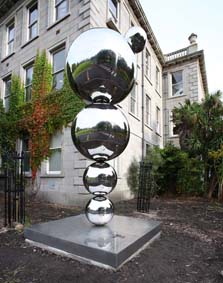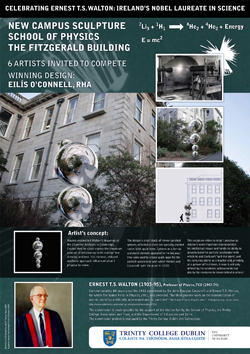'Apples and Atoms' by Eilís O’Connell RHA
Celebrating Ernest T.S. Walton 1903-95, Nobel Laureate
Polished Stainless Steel, 2013Erasmus Smith’s Professor of Natural and Experimental Philosophy, Trinity College Dublin (1946-74)
Nobel Prize for Physics, 1951, jointly awarded with Sir John D. Cockcroft for their pioneering work on the transmutation of atomic nuclei by artificially accelerated atomic particles
Location: FitzGerald Building, School of Physics, Trinity College Dublin

In 1932, Ernest Walton and John Cockcroft split the nucleus of a Li (lithium) atom, often termed ‘splitting the atom’. The experiment was carried out in the Cavendish Laboratory at the University of Cambridge, England. Albert Einstein declared that their experiment was the first demonstration of his famous E=mc2 equation.
Commemorating the 80th anniversary of the experiment, Trinity College Dublin invited six artists to submit a design responding to a brief to commemorate Ernest Walton’s research achievements as well as over 30 years of dedication to science education. Eilís O’Connell’s design was selected by an interdisciplinary panel including representatives from the Walton family, the School of Physics, the College Art Collections, the students, and external visual arts professionals.
Art meets Science, a word from the sculptor Eilís O’Connell RHA
“Having researched Walton’s drawings at the Churchill Archives in Cambridge, I noted that he could convey the maximum amount of information with minimal line drawing and text. His minimal, reduced aesthetic approach influenced what I proposed to make.
Spheres as a formal sculptural element appealed to me because they were used to create spark gaps for the particle accelerator with which Walton and Cockcroft ‘split the atom’ in 1932.
Reflected in the stack of spheres are specially planted native Irish apple trees that refer to the private man and his keen interest for growing fruit trees.
The sculpture pays homage to Walton’s most important characteristics – his intellectual rigour and hands-on ability to physically build the particle accelerator and his nurturing ability as teacher and father. A man is not defined solely by his academic achievements but also by the memories he leaves behind in others.”
The commission was made possible by the support of the Walton family, The Provost, the School of Physics, the Trinity College Dublin Association and Trust, the Department of Education and Skills, the Institute of Physics in Ireland, the Fellows and alumni of Trinity College Dublin and the Science Gallery.
The commission was managed by the Trinity College Dublin Art Collections


